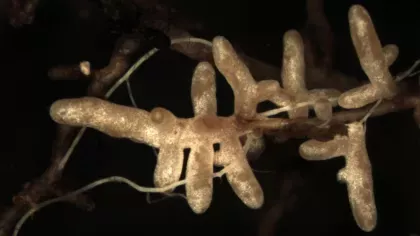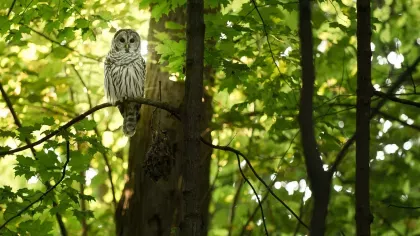12 September 2018
The hidden world of fungi
Fungi are all around you and beneath you, hidden away. They’re helping to keep the natural world alive, functioning, and in balance. Brian Douglas, mycologist at Kew, reveals this mysterious kingdom.

Fungi are everywhere
You may not be aware of it, but wherever you are you are surrounded by fungi.
Imagine a multitude of webs of extremely thin threads, weaving through soil and organic matter such as wood or plant leaves.
Or filaments wrapping around plant roots, or threading around and through living plant cells.
Some webs form in wet habitats, in or around dead or living material - like decomposing leaves in streams, or inside seaweeds.
Some webs interact with animals, harmlessly, or beneficially, or sometimes causing disease.
These webs (“mycelium”) are the bodies of fungi.
Fungi are nearly everywhere, and they comprise a sizable proportion of life and biomass on this planet.
What are fungi?
Fungi are neither plants or animals. They comprise an estimated 2.2-3.8 million or more species placed in their own taxonomic group: Kingdom Fungi.
Their web-like bodies are made of chitin - a very tough molecule also found in the exoskeletons of lobsters and insects.
Many fungi feed by dissolving and threading their way through dead matter, breaking it down much faster than other organisms can.
Other grow on bare soil, rock, or tree bark, capturing and growing around photosynthetic algae or cyanobacteria to become lichens.
The adaptability of fungi allows them to live almost anywhere, from glaciers to the sea bed, tropical rainforests to urban hedgerows, within cow digestive systems, or in compost. Closer to home, fungi live in your washing machine, are on your skin, and can attack your toenails.
Amazing diversity
Fungi produce spore-bearing bodies such as mushrooms when conditions are right, to escape and spread to new places.
But they form more than just mushrooms and moulds – some form earthstars, puffballs, crusts, brackets, cup or coral-like structures, or tiny and strange microscopic structures.
Their spores are transported by wind, water, or by animals, so they can find new places to grow and begin their lifecycles anew.
Each strangely beautiful spore-bearing form has evolved over thousands to millions of years to suit the needs of that species.
Keeping the natural world in balance
Many fungi are recyclers and nutrient-upcyclers, decomposing dead material and then being eaten in turn by many other organisms, especially insects. Some ants even farm them! They are essential links in the food webs of life.
Other fungi form relationships with most trees and plants, wrapping roots or threading around and through living plant cells, and acting as extra-fine fungal “roots” (mycorrhizas). They help plants access nutrients and water in exchange for sugars from the host plant.
Some fungi live harmlessly inside plants, waiting for their hosts to die so they can be first to eat the dead plant tissue.
Sometimes fungi spend their whole life with a host plant, being passed down in seeds and growing plant cells, and can help their plant fight off animals and diseases.
Other fungi make a living by stealing nutrients from living plants, or by killing them to feast on their remains.
Fungal diseases can be a major problem for agriculture or forestry crops, but they also help keep plant communities diverse and in balance in natural ecosystems.
Some fungi cause diseases in animals: controlling the minds of ants and insects; attacking the skin of frogs or bats; or infecting humans.
And fungi are very good at producing complicated chemicals – some of which have become very important medicines for humans
Kew loves fungi
We are addressing many of the knowledge gaps involving this enormous and diverse kingdom of organisms, asking questions like:
- How do we name and categorise fungal diversity, to make sure we can identify fungi and communicate effectively about species?
- How have fungi evolved, and how is this reflected in their morphology and biochemical production, whether in lichens or in fungi cultivated by ants?
- What is the hidden diversity of fungi associated with tree and plant roots?
- How can we protect fungi from destruction by humans and other threats?
- How can we use fungi to benefit humanity, or prevent fungi from causing economic damage by disease to agricultural or forestry crops?
- How can we encourage and support the next generation of mycologists to continue this work into the future?
But the fungal kingdom remains a mysterious group of organisms.
Most people don’t understand how diverse, important, and strangely beautiful these organisms are, and how our existence depends on them.
Along with the State of the World’s Fungi report, mycologists and fungus enthusiasts like us champion the fungal cause in all its aspects. We want a more productive relationship with this essential part of natural world.
And if you look out for them, you’ll see signs of fungi wherever you are.
Explore the amazing world of fungi further in our ground-breaking State of the World's Fungi report


